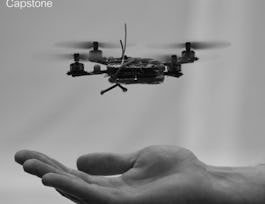How can robots perceive the world and their own movements so that they accomplish navigation and manipulation tasks? In this module, we will study how images and videos acquired by cameras mounted on robots are transformed into representations like features and optical flow. Such 2D representations allow us then to extract 3D information about where the camera is and in which direction the robot moves. You will come to understand how grasping objects is facilitated by the computation of 3D posing of objects and navigation can be accomplished by visual odometry and landmark-based localization.



Robotics: Perception
This course is part of Robotics Specialization


Instructors: Kostas Daniilidis
40,463 already enrolled
Included with 
(653 reviews)
Skills you'll gain
Details to know

Add to your LinkedIn profile
21 quizzes, 1 assignment
See how employees at top companies are mastering in-demand skills

Build your subject-matter expertise
- Learn new concepts from industry experts
- Gain a foundational understanding of a subject or tool
- Develop job-relevant skills with hands-on projects
- Earn a shareable career certificate


Earn a career certificate
Add this credential to your LinkedIn profile, resume, or CV
Share it on social media and in your performance review

There are 4 modules in this course
Welcome to Robotics: Perception! We will begin this course with a tutorial on the standard camera models used in computer vision. These models allow us to understand, in a geometric fashion, how light from a scene enters a camera and projects onto a 2D image. By defining these models mathematically, we will be able understand exactly how a point in 3D corresponds to a point in the image and how an image will change as we move a camera in a 3D environment. In the later modules, we will be able to use this information to perform complex perception tasks such as reconstructing 3D scenes from video.
What's included
15 videos2 readings8 quizzes1 assignment1 programming assignment
Now that we have a good camera model, we will explore the geometry of perspective projections in depth. We will find that this projection is the cause of the main challenge in perception, as we lose a dimension that we can no longer directly observe. In this module, we will learn about several properties of projective transformations in depth, such as vanishing points, which allow us to infer complex information beyond our basic camera model.
What's included
5 videos4 quizzes1 programming assignment
In this module we will be learning about feature extraction and pose estimation from two images. We will learn how to find the most salient parts of an image and track them across multiple frames (i.e. in a video sequence). We will then learn how to use features to find the position of the camera with respect to another reference frame on a plane using Homographies. We will also learn about how to make these techniques more robust, using least squares to hand noisy feature points or RANSAC to remove completely erroneous feature points.
What's included
8 videos5 quizzes1 programming assignment
Now we will use what we learned from two view geometry and extend it to sequences of images, such as a video. We will explain the fundamental geometric constraints between point features in images, the Epipolar constraint, and learn how to use it to extract the relative poses between multiple frames. We will finish by combining all this information together for the application of Structure from Motion, where we will compute the trajectory of a camera and a map throughout many frames and refine our estimates using Bundle adjustment.
What's included
14 videos1 reading4 quizzes1 programming assignment
Instructors

Offered by
Recommended if you're interested in Mechanical Engineering

University of Pennsylvania

University of Pennsylvania

University of Pennsylvania

University of Pennsylvania
Why people choose Coursera for their career




Learner reviews
Showing 3 of 653
653 reviews
- 5 stars
60.33%
- 4 stars
24.34%
- 3 stars
7.81%
- 2 stars
4.13%
- 1 star
3.36%

Open new doors with Coursera Plus
Unlimited access to 7,000+ world-class courses, hands-on projects, and job-ready certificate programs - all included in your subscription
Advance your career with an online degree
Earn a degree from world-class universities - 100% online
Join over 3,400 global companies that choose Coursera for Business
Upskill your employees to excel in the digital economy
Frequently asked questions
Access to lectures and assignments depends on your type of enrollment. If you take a course in audit mode, you will be able to see most course materials for free. To access graded assignments and to earn a Certificate, you will need to purchase the Certificate experience, during or after your audit. If you don't see the audit option:
The course may not offer an audit option. You can try a Free Trial instead, or apply for Financial Aid.
The course may offer 'Full Course, No Certificate' instead. This option lets you see all course materials, submit required assessments, and get a final grade. This also means that you will not be able to purchase a Certificate experience.
When you enroll in the course, you get access to all of the courses in the Specialization, and you earn a certificate when you complete the work. Your electronic Certificate will be added to your Accomplishments page - from there, you can print your Certificate or add it to your LinkedIn profile. If you only want to read and view the course content, you can audit the course for free.
If you subscribed, you get a 7-day free trial during which you can cancel at no penalty. After that, we don’t give refunds, but you can cancel your subscription at any time. See our full refund policy.

